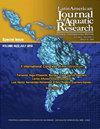眼柄消融和驯化温度对凡纳滨对虾幼虾耐热性的影响:细胞保护氧化应激的分子生物标志物及其补偿机制
IF 0.8
4区 农林科学
Q3 FISHERIES
Latin American Journal of Aquatic Research
Pub Date : 2023-04-30
DOI:10.3856/vol51-issue2-fulltext-2926
引用次数: 0
摘要
本研究探讨了驯化温度和眼柄消融(EA)对南美白对虾幼鱼耐热性的影响。在每种情况下,评估参与细胞保护(hsp70和hsp90)、氧化应激(cMnSOD和GPx)和厌氧代谢(hif1a)的基因的相对表达。为此,将虾在20、26和32°C下驯化21天。驯化后,在非眼柄烧蚀、单侧和双侧眼柄烧蚀的生物体中测定临界热最大值(CTmax)。观察到驯化温度对CTmax值的影响,在32°C下驯化的虾的CTmax值最高。同样,EA导致在20和26°C下驯化的生物体对CTmax的耐热性降低。CTmax后hsp70和hsp90基因表达增加证明了虾的保护性和细胞修复反应,EA增强了这种反应。相反,结果表明,cMnSOD对CTmax非常敏感,并且其表达随着EA而增强,而对于GPx,相对基因表达增加,主要在20°C下驯化的虾中。在hif1a的情况下,在26°C的驯化温度下观察到过度表达,显示出补偿机制的激活,如厌氧代谢。EA在涉及热应激反应、氧化应激和补偿机制的分子生物标志物的CTmax期间引起了显著的分子反应。本文章由计算机程序翻译,如有差异,请以英文原文为准。
Eyestalk ablation and acclimation temperatures affect juveniles Penaeus vannamei thermo-tolerance: molecular biomarkers of cell protection oxidative stress, and compensatory mechanisms
This study investigated the effect of acclimation temperatures and eyestalk ablation (EA) on the thermal tolerance of juvenile Penaeus vannamei. In each case, the relative expression of genes involved in cell protection (hsp70 and hsp90), oxidative stress (cMnSOD and GPx), and anaerobic metabolism (hif1a) was assessed. For this purpose, shrimp were acclimated to 20, 26, and 32°C for 21 days. After acclimation, the critical thermal maxima (CTmax) was determined in non-eyestalk ablated, unilaterally, and bilaterally eyestalk ablated organisms. An effect of acclimation temperatures on CTmax values was observed, with shrimp acclimated at 32°C having the highest rates. Likewise, EA resulted in lower thermal tolerance to CTmax in organisms acclimated at 20 and 26°C. The shrimp's protective and cellular repair responses were evidenced by increased hsp70 and hsp90 gene expression after CTmax and were intensified by the EA. In contrast, the results showed that cMnSOD was very sensitive to CTmax, and its expression was intensified with EA, while for GPx, there was an increase in the relative gene expression, mainly in shrimp acclimated at 20°C. In the case of hif1a, overexpression was observed at the acclimation temperature of 26°C, showing the activation of compensatory mechanisms such as anaerobic metabolism. EA caused a significant molecular response during CTmax of molecular biomarkers involved in heat stress response, oxidative stress, and compensatory mechanisms.
求助全文
通过发布文献求助,成功后即可免费获取论文全文。
去求助
来源期刊

Latin American Journal of Aquatic Research
FISHERIES-MARINE & FRESHWATER BIOLOGY
CiteScore
1.70
自引率
10.00%
发文量
44
审稿时长
4-8 weeks
期刊介绍:
Latin American Journal of Aquatic Research- LAJAR is the continuation of the journal Investigaciones Marinas (1970-2007) and is published since 2008 by the Escuela de Ciencias del Mar, Facultad de Ciencias del Mar y Geografía of the Pontificia Universidad Católica de Valparaíso. LAJAR is an “Open Access” journal that publishes in English language, original research articles, reviews and short communications on aquatic science, which contain the results of research conducted in aquaculture or in oceanic and coastal marine waters of Latin America.
The following topics are considered: Physical Oceanography, Chemical Oceanography, Marine Biogeochemistry, Marine Pollution and Toxicology, Marine Geology and Geophysics, Biological Oceanography, Fisheries and Aquaculture.
 求助内容:
求助内容: 应助结果提醒方式:
应助结果提醒方式:


